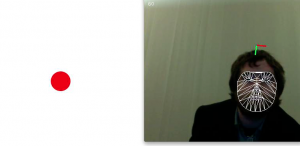OSC Face Ball from Mike Taylor on Vimeo.
This simple Processing demo uses facial movements from Kyle McDonald’s FaceOSC application and Dan Wilcox’s OSC template. At it’s core, this app is a very simple face-controlled physics simulator. As the user looks up, down, left, and right, forces are exerted on the ball which cause it to accelerate in the direction of the user’s gaze. Each time the ball hits the wall, it loses a fraction of its kinetic energy to avoid things from going out of control. There is certainly some room for additional functionality by taking advantage of facial features like mouth and eye height, but these were difficult to test because of faceOSC insisting that my mouth is my mustache.
The Processing code can be found here.
And here:
import oscP5.*;
OscP5 oscP5;
int found;
PVector poseOrientation;
float ballX = 640;
float ballVX = 0;
float ballY = 360;
float ballVY = 0;
float ballM =1;
void setup(){
size(1000,720);
oscP5 = new OscP5(this, 8338);
oscP5.plug(this, "found", "/found");
oscP5.plug(this, "poseOrientation", "/pose/orientation");
poseOrientation = new PVector();
}
void draw(){
background(255);
if (found > 0) {
ballVX -= poseOrientation.y/ballM;
ballX += ballVX;
ballVY += poseOrientation.x/ballM;
ballY += ballVY;
// noStroke();
// lights();
// translate(ballX, 360, 0);
// sphere(25);
// println(ballX);
if (ballX>1000){
ballX=1000;
ballVX=-.7*ballVX;
}
if (ballX<0){
ballX=0;
ballVX=-.7*ballVX;
}
if (ballY>720){
ballY=720;
ballVY=-.7*ballVY;
}
if (ballY<0){
ballY=0;
ballVY=-.7*ballVY;
}
}
ellipseMode(CENTER);
noStroke();
fill(256,0,0);
ellipse(int(ballX),int(ballY),50, 50);
}
public void found(int i) {
found = i;
}
public void poseOrientation(float x, float y, float z) {
println("pose orientation\tX: " + x + " Y: " + y + " Z: " + z);
poseOrientation.set(x, y, z);
}
// all other OSC messages end up here
void oscEvent(OscMessage m) {
if (m.isPlugged() == false) {
}
}
